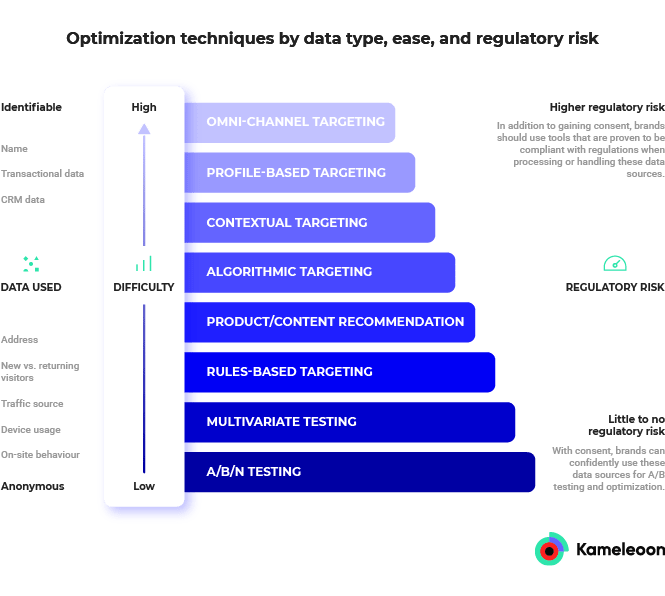
A/B testing in the insurance industry: What top firms are doing
With huge brokerage networks producing tons of customer information and sensitive financial data, most insurance firms put off doing A/B testing and CX optimization because they feel overwhelmed by organizing all the data all while staying regulation-compliant.
Only two out of 10 insurance execs said their firm is applying customer data to optimize.
While it may seem like your insurance company is drowning under a tidal wave of user data, digital-first insurance organizations win out because they are better equipped to reduce the frustration customers feel when shopping for quotes and managing plans online.
No wonder that “insurance firms that use optimization methods all the time are 1.5 times more likely to grow” than those that don’t, according to Forrester research on optimization in the insurance industry.
Here’s how the leading insurtech firms use data and A/B testing to stand out from their competition.
1 Using data for CX optimization
Surveying managers at insurance firms in North America, 79% viewed CX optimization as extremely important. Moreover, 9 out of 10 insurance firms will be dedicated to improving the use of data and analytics to improve CX optimization. If so many insurers see CX optimization as extremely important, what’s stopping them from doing it?
The truth is that digital-first practices are sorely lacking in the insurance industry. Half of the organizations that collect CX data (54%) act on it to improve digital experiences. The other half? They don’t do anything with the data that they collect.
Many insurers, like those in the finance industry, don’t know how to extract actionable insights from the vast amount of data they collect through their intricate brokerage networks. Having to sift through large volumes of data when you don’t know what to look for is a futile exercise. Although the volume and variety of data can be intimidating, insurers must take initiative and embed A/B testing at every customer touchpoint.
A/B testing makes sense of the data and helps insurers to improve their messaging, brand perception, and ultimately, grow their revenue. For example, insurance firms can A/B test different variations of copy on their insurance coverage pages. They can set goals around sign-ups, referral traffic, time spent on-page, and more. This helps insurers understand which kind of messaging drives more conversions, how much time customers are spending reading insurance comparisons before signing up, and how much they are engaging with the page. A/B testing guides insurance firms towards creating a culture of experimentation and optimization.
For example, larger sites with more significant traffic volumes could A/B test title tags within Google SERP results. Changes like this would impact the number of users on your page. Such changes can lead to buy-in for further tech adjustments, new quote engines, hiring of more staff, and more. Ultimately it is about making users' experiences smoother and seamless.
2 Adopting a culture of experimentation
Insurance firms with a “maturing” data and analytics approach are 1.9x times more likely to struggle with data volume and variety than “very mature firms”.
In other words, insurance firms with well-developed, holistic data management strategies can methodically comb through their insights, extract intel, and act on it with greater speed and certainty than their competitors. This data-driven thinking is what separates the leading insurance firms from the pack.
Getting leadership buy-in would unlock significant investments in transformative skills training for employees, clear data management processes, and cutting-edge technology leading to smoother digital-first experiences for consumers.
This requires getting buy-in from leaders at your organization to start testing throughout the business unit. Remember that the goal is not testing to win, but testing to learn.
3 Regularly practicing A/B testing
A/B testing takes the guesswork out of creating personalized, engaging digital experiences. It allows insurers to discover, test, and measure CX optimization strategies that will delight consumers. Forrester found that firms that regularly practice A/B testing, however, were 1.5x more likely to report faster growth.
Today’s customers are dissatisfied with how insurers are serving digital experiences (57%), and A/B testing is the best way to remove uncertainty and gut feeling when making marketing or design decisions for websites, ads or other digital campaigns.
More advanced insurance organizations can work their way up to complex techniques with increasing levels of complexity.

4 Leveraging A/B testing tools that focus on data compliance and privacy
There are a lot of touchpoints and brokers in insurance that lead to inconsistent and unreliable data. Although respondents said their firms are comfortable with risk, one-quarter believe that using anonymous data for CX is risky.
Risk is part and parcel of the insurance industry and many insurers have a solid knowledge of insurance law where they operate. The greater problem is understanding how to solve data inconsistency and quality problems. Insurers must find innovative ways around data collection and management so that they have a trusted starting point for A/B testing and CX optimization.
For this, they use tools like Kameleoon, which is BAA-ready and HIPAA, GDPR, AND CCPA compliant. The platform features powerful data privacy, security, and consent management features.
However, it is also important to remember that there are plenty of basic tests insurers can run without any risk at all. For example;
There are plenty of basic A/B tests you can run, including:
- Test on-page elements
- Website headlines
- Call-to-actions
- Hero images
- Pop-ups
- Pricing offers
- Lead capture: Forms are often the point of resistance that makes users bounce.
- Input fields
- Alignment
- Field labels
- Design
- Accessibility
- Device type (mobile vs. tablet vs. desktop)
- Font sizes
5 Conclusion: A/B testing for insurance firms
Through A/B testing, insurers can go behind customer behaviors, motivations, and attitudes. For example, A/B testing survey forms to get accurate customer feedback on a new product feature to improve CX and increase customer satisfaction.
Insurers that use these analysis methods all the time are 1.5 times more likely to grow and to provide better CX than their counterparts. But only three out of 10 leverage optimization and A/B testing.
How digital-first insurance industry leaders use A/B testing to optimize CX and become insights-driven
To continually refine CX, insurance leaders must seek to optimize each customer interaction by applying data to win, serve, and retain customers. This requires a robust data management strategy inclusive of skills, processes, and technologies. Here’s a recap of what we covered:
- Insurers must embed A/B testing at every customer touchpoint
- Greater speed and certainty due to reliable data management strategies separate the winners
- Leadership buy-in would unlock significant investments in transformative skills training for employees, clear data management processes, and cutting-edge technology leading to smoother digital-first experiences for consumers
- Insurance firms that regularly practice A/B testing are almost 2x more likely to outpace their competitors
- Improving data collection and management processes will help insurance trust their data, therefore, act on it
- Through A/B testing, insurers can go behind customer behaviors, motivations, and attitudes



